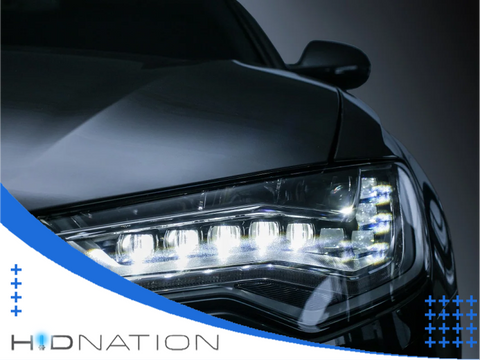Whether you're a night-owl driver or want brighter headlights, HID bulbs are an excellent option. However, not all HID lights are the same.
Choose a bulb with a Kelvin rating of 4300 to 6000 for optimal performance. A lower Kelvin temperature produces yellow light, while a higher rating gives you more blue light.
Traditional halogen headlights are being increasingly replaced by LED (Light Emitting Diode) and HID (High-Intensity Discharge) headlights due to their superior brightness and efficiency.
Understand the Difference Between LED and HID Headlights:
Before diving into the selection process, it's essential to understand the fundamental differences between LED and HID headlights.

LED Headlights:
LED headlights use light-emitting diodes to produce light. They are highly energy-efficient and provide excellent visibility. LED headlights have a longer lifespan than other types of headlights and are known for their instant response and durability.
HID Headlights:
HID headlights, or Xenon headlights, use a high-voltage electrical charge to ionize xenon gas, producing a bright white light. They offer better visibility than halogen headlights and have a longer lifespan. HID headlights require a brief warm-up period before reaching their full brightness. They are available in different color temperatures and are usually installed with ballast to regulate the electrical current.
Produce a Brighter Light
Many drivers upgrade their headlights using a conversion kit or have them installed at the factory. However, determining which type of headlight is best isn’t always straightforward.

Excellent Choice for Drivers
LED and HID lights are excellent choices for drivers who drive at night. They provide a more comprehensive, brighter beam ideal for navigating curves and other hazards on the road. They’re more effective than halogen lights at illuminating the sides of the road, making it easier for drivers to stay on course.
Better Visibility
Both LED, and HID headlights offer better visibility than halogen headlights. When selecting a bulb, it’s essential to consider its brightness, color temperature, and lumens rating. Both LED, and HID headlights are significantly brighter than traditional halogen bulbs. They’re also more efficient and require less maintenance than halogen headlights. In addition, LED and HID headlights produce a much whiter light than halogen bulbs, making it easier for drivers to distinguish colors and objects.
Lumen Output:
A higher lumen output indicates brighter light. Compare the lumen ratings of a different LED or HID headlights to determine which offers the desired brightness for your driving needs.
Beam Pattern:
A well-designed beam pattern is crucial for optimal visibility. Look for headlights with a focused and controlled beam pattern that minimizes glare for oncoming traffic while providing ample illumination of the road ahead. Some headlights may have additional features, such as cut-off lines or projectors, that help create a well-defined beam pattern.
Cost-Effective and Energy Efficient Headlights
For decades, the halogen bulb reigned unchallenged as the standard for automotive headlights. But in recent years, other lights offer drivers an alternative. These include HID (high-intensity discharge) bulbs and LED bulbs. While the latter are more expensive, they last longer and use less power than halogen bulbs. They also produce a more natural, less yellow light that some drivers prefer. The downside is that they can reflect a lot of glare into oncoming traffic.
Another benefit of HID lights is that they can illuminate the roadway for longer distances than halogen headlights.

One downside of HID lights is that they need to warm up before they emit light. This can make them dimmer than halogen bulbs. Moreover, the emitted light may not be focused, which can cause problems with other motorists.
LED headlights are becoming more popular with car owners because of their energy efficiency and durability. They are more affordable than halogen bulbs and emit brighter light, which helps improve road visibility. They also do not generate much heat, which can prevent them from burning out. In addition, they are also smaller, which allows them to be used in a variety of applications.
Best Option in Terms of Durability
If you’re upgrading your car’s headlights, you need to choose one of the best headlights: LED or HID headlights. These two technologies offer a significant upgrade over traditional halogen bulbs but have different advantages and drawbacks. Both are excellent choices for drivers who want a brighter, longer-lasting headlight, but which is the best choice for your vehicle?
Both LED, and HID headlights are an improvement over halogen bulbs in terms of brightness and durability. However, they differ in their energy efficiency and light color temperature. HID headlights are better at producing a more natural-looking white light, while LED lights are typically yellow or tinted.
LED Color Temperature:
LED headlights come in various color temperatures, including cool white (5000K-6500K), pure white (6000K-7000K), and blue-white (8000K-10000K). Cooler temperatures tend to provide better visibility, while warmer temperatures may offer a more pleasant appearance.
HID Color Temperature:
HID headlights are available in a similar range of color temperatures as LED headlights. However, they tend to produce a slightly different color spectrum. HID headlights' most common color temperatures are 4300K, 6000K, and 8000K. Lower temperatures provide a more yellowish light, while higher temperatures produce bluer light. Choose a color temperature that suits your preference, considering that some extraordinarily high or low temperatures may not be legal in certain regions.
If you are a daytime commuter, then you may prefer halogen headlights. If you’re unsure about what type of headlight to choose, contact an experienced mechanic or speak with a specialist at HID Nation.
Whether you get HID or LED headlights, they can dramatically improve your nighttime visibility. Both lights are brighter than halogen bulbs, providing a clearer view for the driver and other road users. Moreover, they offer a more extended range than halogen lights and emit fewer glares.
Conclusion
Choosing the best LED or HID headlights for your car involves considering factors such as brightness, visibility, color temperature, energy efficiency, durability, and compatibility. By understanding the differences between LED and HID headlights and evaluating these factors, you can make an informed decision that enhances your driving experience and safety on the road. Remember to check local regulations, read reviews, and set a budget to find the headlights that meet your specific needs. Drive safely with the proper headlights for your car.
Read Also: Enlightening Your Drive with 12 Volt LED Lights – Improve Safety of Ride
FAQs
Which one is more energy-efficient, LED or HID headlights?
LED headlights are generally more energy-efficient compared to HID headlights. LEDs require less power to operate, which can lead to fuel savings and less strain on the car's electrical system. LED headlights consume about 30-60% less energy than HID headlights, making them a greener and more cost-effective choice.
Are LED or HID headlights brighter?
HID headlights are generally brighter than LED headlights. HID technology produces a more intense light output, providing enhanced visibility in darker or foggy conditions. However, modern LED headlights have significantly increased brightness and can provide excellent illumination, making them popular among car owners.
Do LED or HID headlights last longer?
LED headlights have a longer lifespan compared to HID headlights. On average, LED headlights can last anywhere between 30,000 to 50,000 hours, while HID headlights typically last around 2,000 to 3,000 hours. This longevity is due to the solid-state design of LEDs, which are more durable and less prone to failure than HID bulbs.
Can I retrofit LED or HID headlights in my car?
Retrofitting LED or HID headlights in your car depends on various factors, including your car's make, model, and existing lighting system. Some vehicles may have compatible LED or HID conversion setups, while others require additional modifications or adapters.
Which option is more expensive, LED or HID headlights?
However, the price gap has narrowed as LED technology becomes more widespread and affordable. Despite the higher upfront cost, LED headlights offer longer lifespan, energy efficiency, and potential cost savings over time. Additionally, prices can vary depending on the headlights' brand, quality, and features.
Which option should I choose for my car, LED or HID headlights?
LED headlights are ideal for prioritizing energy efficiency, longevity, and various design options. On the other hand, HID headlights are suitable if you prioritize brightness and improved visibility, especially for long-distance driving or in areas with poor lighting conditions. Consider factors such as your budget, local regulations, and the compatibility of your vehicle when making a decision.



